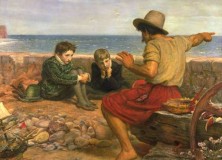We all tell stories. Be it in the elegant prose of a finely-crafted novel or merely relaying the day’s events to someone else, this capacity for storytelling is something found across our various cultures and has its roots deep in our prehistory. Stories are powerful tools with which we understand the world and share social information. They can also be dangerous. In the art of weaving together a tale, details might be omitted, others highlighted and some manipulated. Simple stories, where we abstract away from our complex and messy lives, are especially prone to this narrative fallacy, where we take facts and force an explanation into them, which, in the words of Nassim Nicholas Taleb, is misleading when it “increases our impression of understanding”. A similar warning is made in this brilliant video by Professor Tyler Cowen (of Marginal Revolution):
N.B. The featured picture is of the painting The Boyhood of Raleigh by John Everett Millais. The story behind its use here is simple: it appears on the storytelling page of wikipedia. It also began me on a quest of hyperlink jumps, but that’s another story… Yawn.


i often say that an example or a story is an illustration. that’s a cue to readers not to add that into the points of evidence, but rather it’s just a way to make the overall contention more vivid and clear.
Yeah, it would be wise if most people went in thinking about a story as an illustration. It’s interested that you mention readers: in stories, there’s a clear tension between them and the writer. A writer might use an example to make something clearer, but there is no explicit instruction for the reader to follow that logic: in fact, they’ll reconstruct their own meaning, using their prior knowledge and inferential capacities… But let’s not go down the road of induction 😉